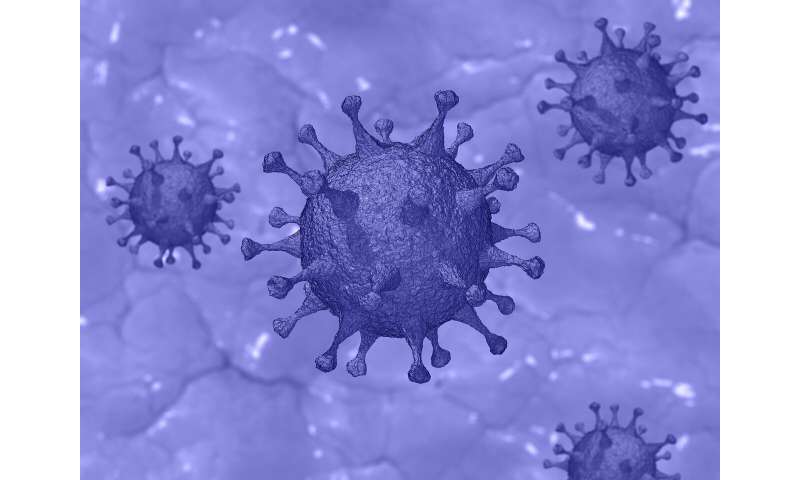
A literature review by a University at Buffalo researcher reveals two noteworthy findings related to COVID-19 and patients with neuromuscular disorders.
The research shows that the novel coronavirus can bring on neuromuscular conditions in patients who previously had none, and that the virus can exacerbate symptoms in patients with preexisting conditions and who are being treated with immunotherapies.
The study, titled “Neuromuscular Complications of COVID-19: A Review of the Literature,” was conducted by Gil I. Wolfe, MD, Irvin and Rosemary Smith Professor and Chairman of the Department of Neurology at the Jacobs School of Medicine and Biomedical Sciences at UB and president of UBMD Neurology.
Co-authors of the study were Tiffany Pike-Lee, MD, and Yuebing Li, MD, both of the Neuromuscular Center, Department of Neurology, at the Neurological Institute at the Cleveland Clinic. The paper is being published in the online RRNMF Neuromuscular Journal.
Wolfe and his colleagues reviewed every English language article mentioning COVID-19 and neuromuscular conditions published from the start of the pandemic and running through June 18, 2020—a total of 547 publications.
“Although neuromuscular complications of COVID-19 have not received as much publicity as stroke complications, they are being increasingly reported,” Wolfe said. “Guillain-Barré syndrome, a severe life-threatening paralyzing neuropathy that is a complication of many viral infections, has now been seen in COVID-19 patients in many countries, including the United States.”
The literature indicated that since the pandemic hit, 27 cases of Guillain-Barré syndrome stemming from the virus have been reported worldwide. Three of the cases were a variant of GBS, the Miller Fisher variant.
GBS cases were reported in Austria, China, France, Germany, Italy, Iran, Morocco, Spain, Switzerland, Turkey and the U.S. Italy and the U.S. had the most reported cases, with 10 and four, respectively. The mean age of the patients was 59.8; 63 percent were male. Forty-four percent of the patients—or 12—had to be ventilated.
The literature showed that 16 of the patients, or 59 percent, demonstrated clinical improvement or achieved full or near full recovery, while nine, or 33.3 percent, did not show significant improvement or had a worsening clinical status. The paper noted that of the 16 patients who improved, 14 were treated with intravenous immunoglobulin. Outcomes were not reported for the remaining two. No fatalities were reported.
“While we consider GBS a treatable neuropathy with slow recovery over time, it does appear that many of the COVID-19 patients are following a more refractory course,” Wolfe said. “Time will tell how they do, since the recovery phase can last a year or two.”
Two other neuromuscular disorders, myopathy and hyperCKemia, were reported complications of COVID-19 in the reviewed literature.
In myopathy, the patients’ muscle fibers do not function properly, resulting in weakness, cramps, stiffness, and spasms.
The UB paper noted that in a study of 214 COVID-19 patients in Wuhan, China, 10.7 percent of the patients showed evidence of hyperCKemia, skeletal muscle injury, defined as muscle pain, along with high creatine kinase levels. Of the 88 patients with severe infection, the incidence of skeletal muscle injury increased to 19.3 percent, compared to just 4.8 percent in the 126 patients with mild infections.
Patients with pre-existing neuromuscular disorders such as myasthenia gravis (MG) tend to be more vulnerable to infections like COVID-19, and the infection often exacerbated their conditions, the researchers reported. In addition, they said, immunotherapy treatments place these patients at greater risk of infection.
The literature suggests that MG patients may be at a higher risk for contracting COVID-19 and developing secondary complications.
To date, seven MG patients in the U.S. have been reported to have contracted COVID -19. Of these, six were positive for acetylcholine receptor antibody, and one was positive for muscle specific tyrosine kinase antibody. Three patients required mechanical ventilation for respiratory failure, and one required significant supplemental oxygen. The outcomes were fairly good for six of the patients, with only one patient still intubated at day 35.
The researchers concluded from their review that neuromuscular patients on immunotherapy and those with respiratory dysfunction secondary to their neuromuscular disease should be considered high risk for severe COVID -19 infection and complications. These patients should be encouraged to notify their healthcare provider immediately if there are signs suspicious for COVID -19 infection, the researchers said.
Source: Read Full Article
